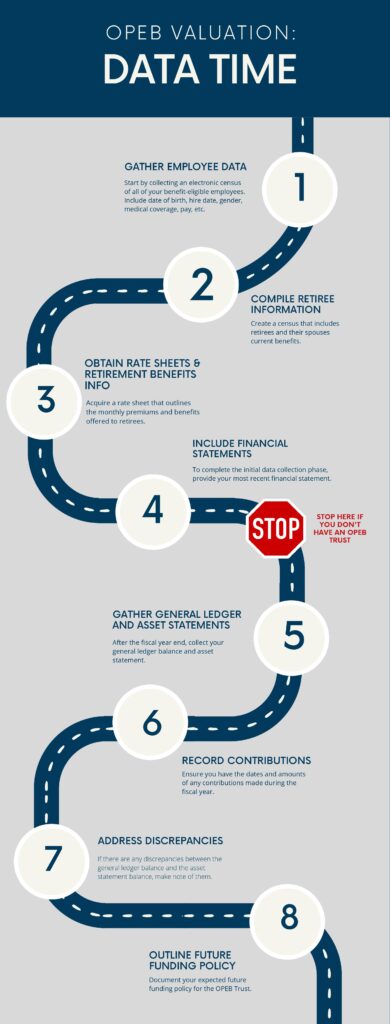OPEB Valuation Data Made Easy: A Step-by-Step Guide
July 20, 2023|Samantha Schneider

Bottom Line Up Front
- Contrary to popular belief, OPEB valuations can be straightforward with the right approach and expert assistance.
- Gather essential employee and retiree information, financial statements, and rate sheets to ensure a comprehensive valuation.
- Let your experience actuaries handle the complex calculations and provide an easy-to-understand valuation that auditors will appreciate.
OPEB valuations are often labeled complex and tedious, but let’s debunk that myth right away. With the right data and assistance from expert actuaries, preparing for an Other Postemployment Benefits (OPEB) valuation can be a smooth and straightforward process. In this article, we will guide you through the necessary data collection and highlight the key steps to ensure a hassle-free OPEB valuation. So, let’s dive in!
Step 1: Gather Employee Data
Start by collecting an electronic census of all your benefit-eligible employees. This should include essential information such as date of birth, hire date, gender, medical coverage, compensation amount, and other pertinent details. Other information usually includes: an identifier (SSN, employee number), job (are they a teacher or a public safety officer?), how much life insurance do they receive in retirement, and enterprise entity members.
Step 2: Compile Retiree Information
Create a census that includes retirees and their spouses currently receiving benefits. Ensure you have their date of birth, date of retirement (only needed for situations where cost-sharing or benefits are dependent upon it), gender, medical coverage, and other relevant details. This information will contribute to a comprehensive valuation.
Upcoming Census Audit? Check out these 9 things to review
Step 3: Obtain Rate Sheets and Retirement Benefits Information
Acquire a rate sheet that outlines the monthly premiums and cost sharing for benefits offered to retirees including any Medicare Supplement plans. Additionally, gather retirement eligibility requirements and the duration and specifics of benefits offered in retirement. These details are crucial for accurate calculations and projections.
Step 4: Include Financial Statements
To complete the initial data collection phase, provide your most recent financial statement. This statement will offer insights into the financial health of your entity and is important for the overall evaluation process.

Stop Here If You Don’t Have an OPEB Trust
If your entity is funding an OPEB Trust, there are a few additional pieces of information required. However, if you do not have an OPEB Trust, feel free to skip this section.
Unsure about prefunding your OPEB? Here are the top 6 reasons you should
Step 5: Gather General Ledger and Asset Statements
After the fiscal year end, collect your general ledger balance and OPEB Trust asset statement. These statements provide crucial information for assessing the financial position of your OPEB Trust.
Step 6: Record Contributions
Ensure you have the dates and amounts of any contributions made during the fiscal year. This information aids in determining the funding status of your OPEB obligations.
Step 7: Address Discrepancies
If there are any discrepancies between the general ledger balance and the asset statement balance, make note of them. Providing an explanation will assist in reconciling any inconsistencies and ensuring accurate calculations.
Step 8: Outline Future Funding Policy
Document your expected future funding policy for the OPEB Trust. This policy will guide the valuation and help establish long-term sustainability.
Once you’ve gathered all the information that you need, it’s time to pass it on to the subject matter experts! Your actuaries are ready to use the data you gather to provide a comprehensive, easy-to-read valuation your auditors will love. Leave the hard work on your OPEB Valuation to the experts like Odyssey Advisors, because we’re those weird math people who absolutely love playing with Excel alllllll day long. OPEB valuations don’t have to be daunting when you have the right team by your side!
Categories: OPEB

About The Author Before coming to Odyssey Advisors, Samantha spent 8 years as a high school math teacher, working mostly with students in low-income, at-risk communities. She users her education background to make sure clients understand the often complex world of retirement benefits...
More Insights From This author





